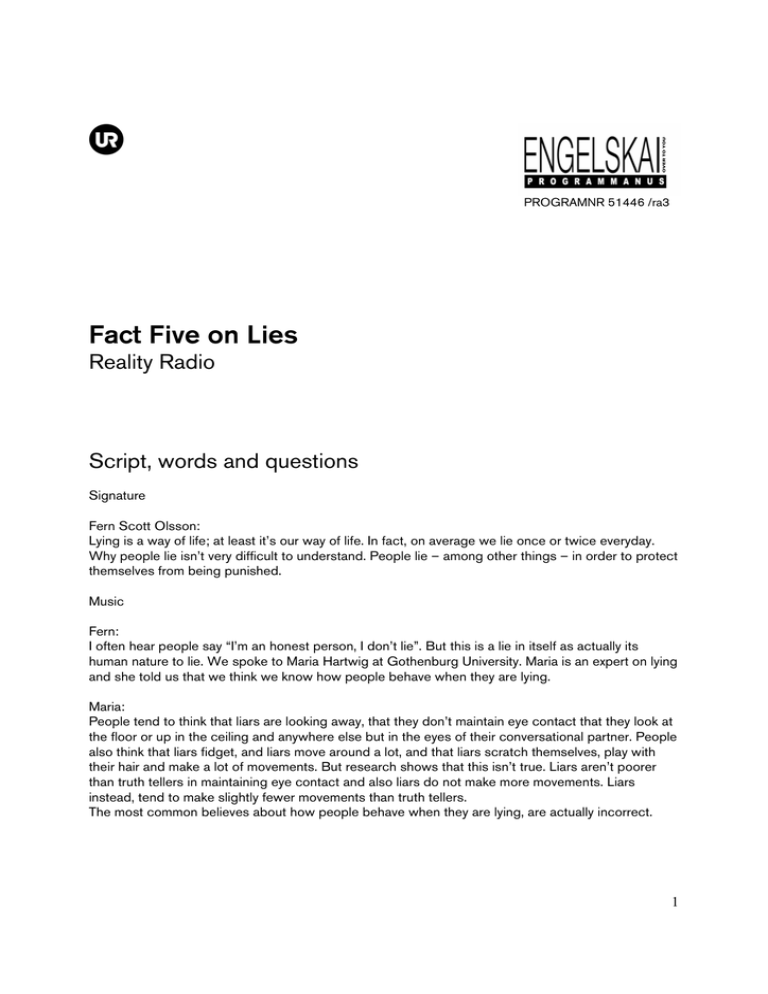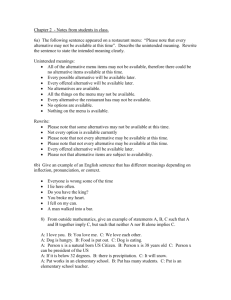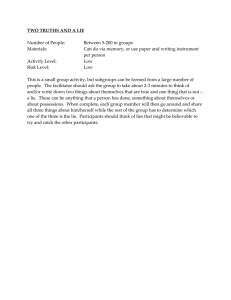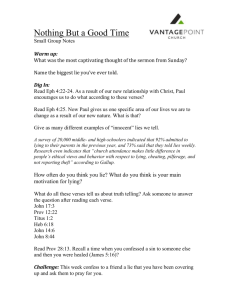Fact Five on Lies
advertisement

PROGRAMNR 51446 /ra3 Fact Five on Lies Reality Radio Script, words and questions Signature Fern Scott Olsson: Lying is a way of life; at least it’s our way of life. In fact, on average we lie once or twice everyday. Why people lie isn’t very difficult to understand. People lie – among other things – in order to protect themselves from being punished. Music Fern: I often hear people say “I’m an honest person, I don’t lie”. But this is a lie in itself as actually its human nature to lie. We spoke to Maria Hartwig at Gothenburg University. Maria is an expert on lying and she told us that we think we know how people behave when they are lying. Maria: People tend to think that liars are looking away, that they don’t maintain eye contact that they look at the floor or up in the ceiling and anywhere else but in the eyes of their conversational partner. People also think that liars fidget, and liars move around a lot, and that liars scratch themselves, play with their hair and make a lot of movements. But research shows that this isn’t true. Liars aren’t poorer than truth tellers in maintaining eye contact and also liars do not make more movements. Liars instead, tend to make slightly fewer movements than truth tellers. The most common believes about how people behave when they are lying, are actually incorrect. 1 Fern: However, more experienced liars know about body language and they behave in a way that we would not expect them to behave. One police officer told us that some criminal suspects can be so relaxed while waiting to be interviewed that they can fall asleep. Maria told us that what we actually say - or rather the words we choose - can give us away more often than our body language. Maria: For example, liars tend to say what didn’t happen rather than what did happen. Liars tend to say things a bit more backwards, like “it wasn’t like this and that” while truth tellers tend to say “it was like this and that”. Liars tend to make fewer of these normal mistakes that people make when they speak. We call them ordinary imperfections. For example, truth tellers are more likely to say “it happened at five o’clock, no wait, it happened at four thirty”. And they tend to make these corrections spontaneously. Liars are less prone to do that, to correct themselves. Fern: We wonder, is it harder to remember the more complicated lies? Maria: Liars pay a lot of attention to what they said the last time and try to create the same account again. While truth tellers on the other hand are interested in recreating the event and they try to say exactly what they remember. What they tell at one time may be a bit different from what they tell another time. Liars are interested in saying the same thing every time they are asked to tell about this thing, because they don’t want to contradict themselves so they tend to remember what they said the first time they talked about it, so they tend to repeat that. Fern: So when do we start to lie? Psychologists say it’s a normal part of children’s development, and that kids at four or five years of age already start to lie. But what’s funny is they act in a way that we would expect liars to act. They fidget, they blush, and they don’t look at the person with whom they are speaking in the eye. However, young children quickly learn that this kind of behaviour doesn’t work, so they change their behaviour and by the age of ten or eleven kids are just as good at lying as adults are. Signature Words: Honest = ärlig Fidget = skruva på sig nervöst Imperfection = brist, fel, defekt Prone = benägen, ha lätt för Contradiction = motsägelse Tend = tendera, luta Blush = rodna Behaviour = beteende Ceiling = innertak 2 Discussion Questions: Easy 1. When do we start to lie? 2. How many times a day do persons in average lie? 3. Why do people lie according to Fern? Advanced 1. How can you tell a person is lying? 2. What are ordinary imperfections? 3. Are some lies more accepted than others? Why? 3







